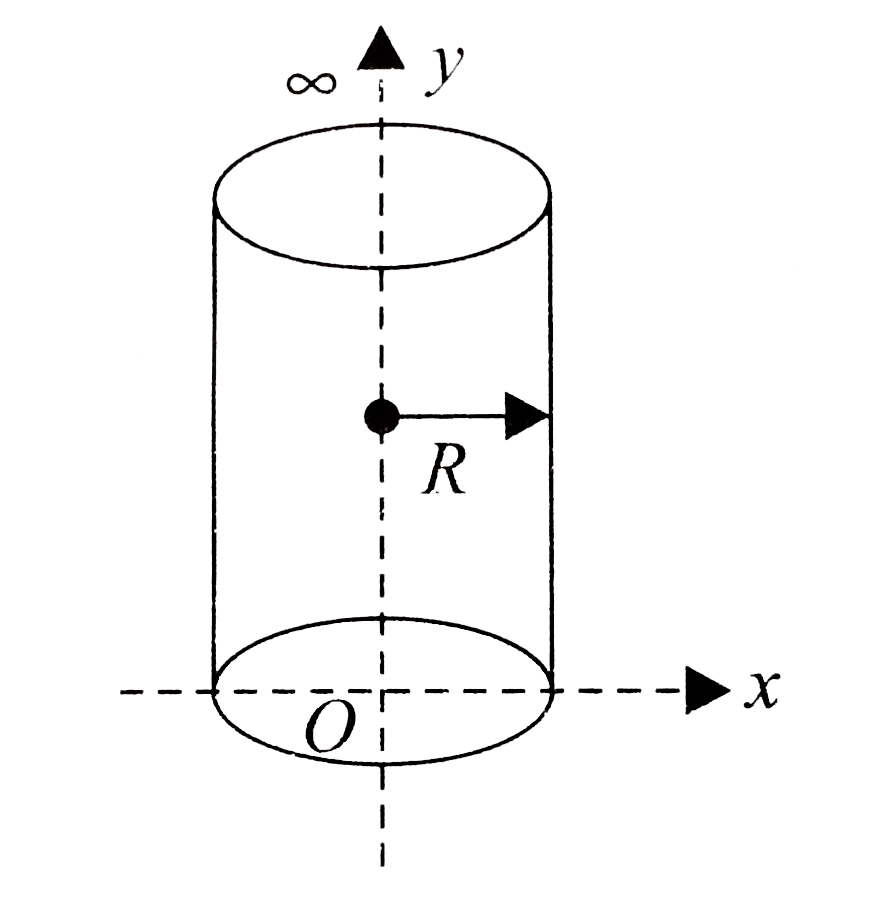Current density in a cylindrical wire of radius R is gives as
⎧⎪⎨⎪⎩J0(XR−1)for 0≤x<R2J0XR forR2≤X≤R . The current flowing in the wire is
724πJ0R2
16πJ0R2
712πJ0R2
512πJ0R2
The correct Answer is:D
To find the current flowing in the cylindrical wire with the given current density, we can follow these steps:
Step 1: Understand the Current Density Function
The current density J is given in two regions:
1. For 0≤x<R2:
J=J0(xR−1)
2. For R2≤x≤R:
J=J0(xR)
Step 2: Define the Differential Current Element
The differential current dI flowing through a differential area dA is given by:
dI=J⋅dA
For a cylindrical wire, the differential area dA at a distance x from the center is:
dA=2πxdx
Step 3: Set Up the Integral for Current
The total current I can be found by integrating dI over the entire cross-sectional area of the wire:
I=∫R0J⋅dA=∫R0J⋅(2πxdx)
Step 4: Split the Integral into Two Parts
We will split the integral into two parts based on the regions defined for J:
I=∫R/20J0(xR−1)(2πx)dx+∫RR/2J0(xR)(2πx)dx
Step 5: Calculate the First Integral
For the first integral:
I1=∫R/20J0(xR−1)(2πx)dx
This simplifies to:
I1=2πJ0∫R/20(x2R−x)dx
Calculating the integral:
=2πJ0(x33R−x22)R/20=2πJ0((R/2)33R−(R/2)22)=2πJ0(R224−R28)=2πJ0(R224−3R224)=2πJ0(−2R224)=−πJ0R212
Step 6: Calculate the Second Integral
For the second integral:
I2=∫RR/2J0(xR)(2πx)dx
This simplifies to:
I2=2πJ0∫RR/2x2Rdx=2πJ0R(x33)RR/2=2πJ0R(R33−(R/2)33)=2πJ0R(R33−R324)=2πJ0R(8R324−R324)=2πJ0R⋅7R324=14πJ0R224=7πJ0R212
Step 7: Combine the Results
Now, we combine I1 and I2:
I=I1+I2=−πJ0R212+7πJ0R212=6πJ0R212=πJ0R22
Final Answer
The total current flowing in the wire is:
I=πJ0R22
The current density J is given in two regions:
1. For 0≤x<R2:
J=J0(xR−1)
2. For R2≤x≤R:
J=J0(xR)
The differential current dI flowing through a differential area dA is given by:
dI=J⋅dA
For a cylindrical wire, the differential area dA at a distance x from the center is:
dA=2πxdx
The total current I can be found by integrating dI over the entire cross-sectional area of the wire:
I=∫R0J⋅dA=∫R0J⋅(2πxdx)
We will split the integral into two parts based on the regions defined for J:
I=∫R/20J0(xR−1)(2πx)dx+∫RR/2J0(xR)(2πx)dx
For the first integral:
I1=∫R/20J0(xR−1)(2πx)dx
This simplifies to:
I1=2πJ0∫R/20(x2R−x)dx
Calculating the integral:
=2πJ0(x33R−x22)R/20=2πJ0((R/2)33R−(R/2)22)=2πJ0(R224−R28)=2πJ0(R224−3R224)=2πJ0(−2R224)=−πJ0R212
For the second integral:
I2=∫RR/2J0(xR)(2πx)dx
This simplifies to:
I2=2πJ0∫RR/2x2Rdx=2πJ0R(x33)RR/2=2πJ0R(R33−(R/2)33)=2πJ0R(R33−R324)=2πJ0R(8R324−R324)=2πJ0R⋅7R324=14πJ0R224=7πJ0R212
Now, we combine I1 and I2:
I=I1+I2=−πJ0R212+7πJ0R212=6πJ0R212=πJ0R22
The total current flowing in the wire is:
I=πJ0R22
Topper's Solved these Questions
- CURRENT ELECTRICITYBOOK - MOTIONCHAPTER - CURRENT ELECTRICITYEXERCISE - EXERCISE -2 (Level-1) SECTION C,D - Circuit theory , KCL & KVL, Battery , Grouping of cells
14 Videos
- CURRENT ELECTRICITYBOOK - MOTIONCHAPTER - CURRENT ELECTRICITYEXERCISE - EXERCISE -2 (Level-1) SECTION E- Electrical Power & Energy
8 Videos
- CURRENT ELECTRICITYBOOK - MOTIONCHAPTER - CURRENT ELECTRICITYEXERCISE - EXERCISE -2 (Level -I) SECTION A- Definition of Current , Current Density , Drift Velocity
6 Videos
- CONSTRAINED MOTION BOOK - MOTIONCHAPTER - CONSTRAINED MOTION EXERCISE - EXAMPLES
12 Videos
- ELASTICITYBOOK - MOTIONCHAPTER - ELASTICITYEXERCISE - EXERCISE -3
60 Videos
Similar Questions
(a) The current density in a cylindrical wire of radius R=2.0mm is uniform across a cross section of the wire and is J=2.0×105A/m2. What is the current through the outer portion of the wire between radial distances R/2 and R?
(b) Suppose, instead, the current density through a cross section varies with radial distance r as J=ar2, in which a=3.0×1011A/m4 and r is in meters. What now is the current through the same outer portion of the wire?
View SolutionThe current density in a cylindrical conductor of radius R varies according to the equation J=J0(1−rR), where r=distacnce from the axis. Thus the current density is a maximum J0 ata the axis r=0 and decreases linealy to zero at the srface r=2√π. Current in terms of J0 is given by n(J06) then value of n will be.
View Solution
Knowledge Check
Current density in a cylindrical wire of radius R is given as J=⎧⎪⎨⎪⎩J0(xR−1) for 0≤x<R2J0xR for R2≤x≤R . The current flowing in the wire is :
A724πJ0R2B16πJ0R2C712πJ0R2D512πJ0R2The current density is a solid cylindrical wire a radius R, as a function of radial distance r is given by J(r)=J0(1−rR) . The total current in the radial regon r = 0 to r=R4 will be :
A5J0πR232B5J0πR296C3J0πR264DJ0πR3128A cylindrical wire of radius R has current density varying with distance r form its axis as J(x)=J0(1−r2R2) . The total current through the wire is
AπJ0R22B2πJ0R23C4πJ0R23Dnone of these
The current density across a cylindrical conductor of radius R varies in magnitude according to the equation J=J0(1−rR) where r is the distance from the central axis. Thus, the current density is a maximum J0 at that axis (r = 0) and decreases linearly to zero at the surface (r = R). Calculate the current in terms of J0 and the conductor 's cross - sectional area A=πR2.
View SolutionA current is flowing through a cylinderical conductor of radius R, such that current density at any cross-section is given by J=J0(1−rR), where r is radial distance from axis of the cylinder .Calculate the total current through the cross-section of the conductor.
View SolutionAn infinite cylindrical wire of radius R and having current density varying with its radius r as, J=J0[1−(r/R)]. Then answer the following questions.

Graph between the magnetic field and radius is
View SolutionAn infinite cylindrical wire of radius R and having current density varying with its radius r as, J=J0[1−(r/R)]. Then answer the following questions.

Position where magnetic field strength is maximum.
View SolutionAn infinite cylindrical wire of radius R and having current density varying with its radius r as, J=J0[1−(r/R)]. Then answer the following questions.

Magnitude of maximum magnetic field is
View Solution
